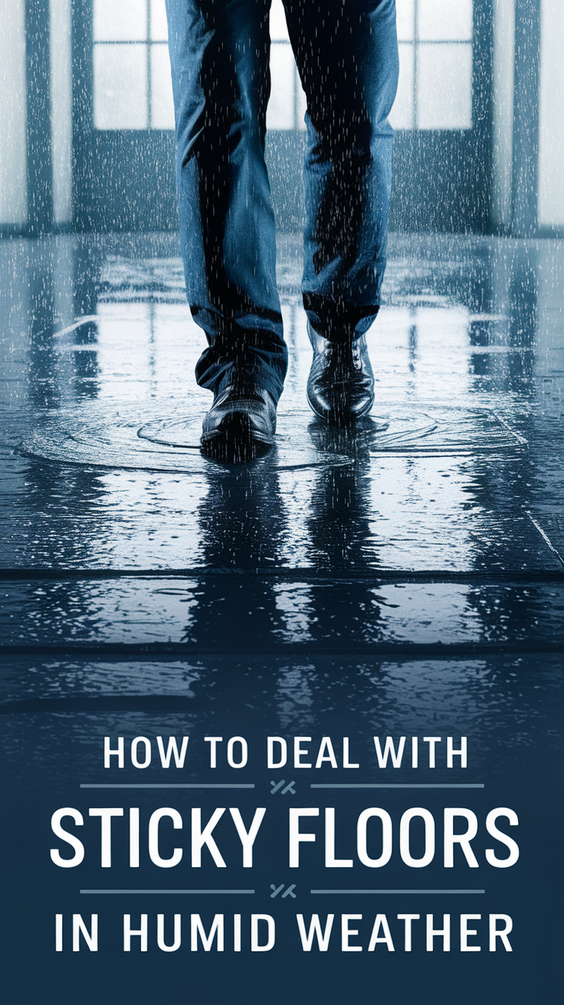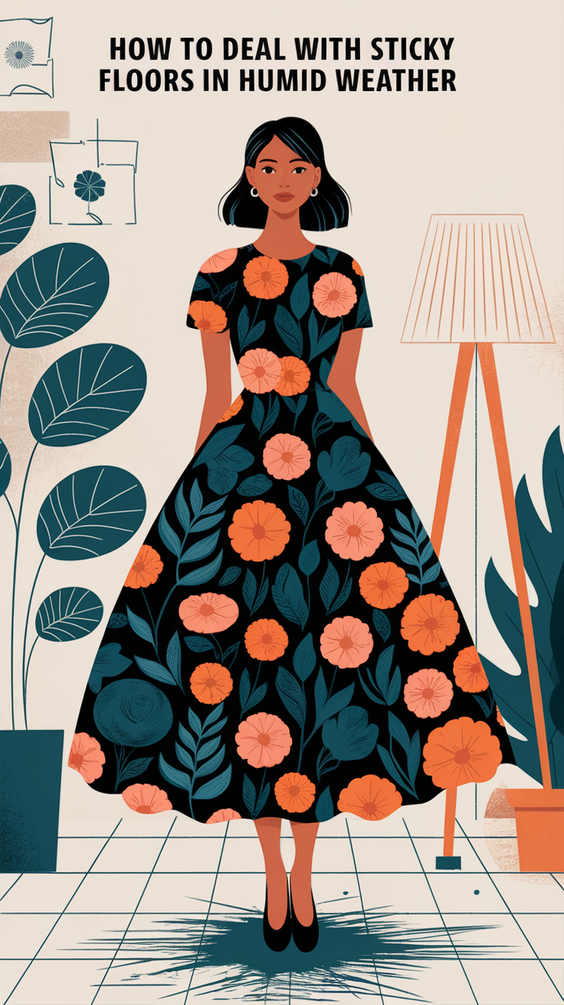How to Deal with Sticky Floors in Humid Weather in 2025

Why Do Floors Become Sticky in Humid Weather?
When you walk across your floor without shoes during summer mornings your feet become stuck to the surface. You’re not alone.
Many parts of the U.S. experience increased extreme humidity in 2025 which has transformed floors into sticky surfaces that create frustrating summer living conditions. All flooring materials including wood, laminate and vinyl become susceptible to moisture in the air. The result? The surface appearance of clean floors conceals an unpleasant sticky sensation when you walk on them.
This guide explains sticky floor science while revealing standard mistakes and delivering tested solutions you can start using immediately. Our guide delivers cleaning hacks and humidity control methods which will help you recover your flooring while regaining comfort in your home.
This article addresses homeowners, renters, parents, pet owners as well as anyone who wants to maintain smooth floors throughout humid seasons.
Understanding What Causes Sticky Floors
Humidity transforms the state of your flooring materials in addition to being merely bothersome.
The Science Behind the Stickiness
Air becomes sticky because humidity increases water content in the atmosphere. Moisture from humid air collects on surfaces that remain cool such as floors specifically in homes with poor ventilation. The prolonged presence of humidity results in an undetectable surface film which draws both debris and cleaning materials to itself.
Top Contributors to Sticky Floors in Humidity
-
High indoor humidity (above 60%)
-
Improper cleaning techniques
- Soaps and cleaning agents should be used moderately.
- Strong and durable flooring materials together with fresh coatings represent essential elements for floor maintenance.
-
Poor airflow and ventilation
Your home probably contains at least one of these common moisture-related issues.
The Response of Various Floor Materials to Humidity Conditions is Examined in this Section.
Different floors react differently to humid weather conditions. Several types of surfaces tend to stick together or develop warping issues.
Wood and Engineered Hardwood
Natural wood expands because it takes in moisture. When wood expands from moisture absorption it develops cupping or unevenness that creates areas where dirt and residue can become trapped.
Vinyl and Laminate
High levels of humidity can make these materials sticky because condensation becomes trapped or because improper cleaning products are used.
Tile and Stone
The materials exhibit reduced stickiness yet they can feel slippery and damp to touch. Grout lines create a breeding ground for moisture that allows microbial growth.
Quick Reference Table: Humidity Impact by Flooring Type
| Flooring Type | Humidity Risk | Stickiness Potential | Ideal Solution |
|---|---|---|---|
| Wood | High | High | Dehumidifier, gentle mop |
| Laminate | Moderate | High | Low-residue cleaner |
| Vinyl | Moderate | Moderate | Microfiber + vinegar mix |
| Tile | Low | Low | Ensure grout is sealed |
Are You Cleaning Your Floors the Wrong Way?
Believe it or not, cleaning habits are one of the biggest reasons your floors feel sticky.
Common Cleaning Mistakes
-
Using too much detergent
Even small amounts of soap can leave residue, especially in humid air. -
Skipping the rinse step
If you’re not mopping with clean water after using cleaner, the residue stays behind. -
Mopping with hot water only
Hot water opens floor pores, allowing moisture to settle deeper. -
Ignoring drying time
Leaving floors damp in humid air causes extended tackiness.
Pro Tip:
Try using distilled water with a few drops of white vinegar—it evaporates quicker and doesn’t leave residue.
Step-by-Step: How to Clean Sticky Floors in Humid Weather
Let’s break it down into actionable steps:
-
Vacuum or dry sweep first to remove loose debris.
-
Use a microfiber mop with a solution of vinegar + water (1:10 ratio).
-
Avoid soaps and multipurpose cleaners.
-
Rinse with clean water using a second mop or cloth.
-
Dry thoroughly using a fan or open windows.
“Less is more when it comes to cleaning solutions in humidity.” — Jenna Adams, Flooring Expert, HomeCare Labs
Keep Humidity in Check: Ventilation and Dehumidification
Even perfect cleaning won’t matter if humidity stays high.
How to Monitor and Control Humidity Levels
-
Install a hygrometer (you can get one for under $20).
-
Aim for indoor humidity between 40-50%.
-
Use exhaust fans in kitchens and bathrooms.
-
Invest in a dehumidifier for key areas like bedrooms and basements.
Best Dehumidifiers for 2025: Quick Comparison
| Model | Area Coverage | Noise Level | Price Range |
|---|---|---|---|
| Frigidaire 50-Pint | Up to 4,500 sq. ft. | Quiet | $230–$280 |
| hOmeLabs 35-Pint | Up to 3,000 sq. ft. | Moderate | $180–$220 |
| Midea Cube | Up to 4,500 sq. ft. | Low | $240–$300 |
Thinking long-term? A whole-home HVAC-integrated system could be your best bet.
Prevent Sticky Floors with Smart Daily Habits
Want to avoid the problem altogether? Adjust your routine:
-
Dry spills and wet footprints immediately.
-
Keep entryway rugs clean and dry.
-
Use ceiling fans or stand fans to circulate air daily.
-
Avoid going barefoot on freshly cleaned floors.
Did you know?
Even your pet’s wet paws can contribute to that subtle sticky buildup. Wipe them down after walks.
Still Sticky? It Might Be a Deeper Problem
If floors remain sticky despite all your efforts, it’s time to dig deeper.
When to Investigate Further
-
Signs of moisture under floorboards
-
Warped or buckling panels
-
Moldy smell or dark patches
-
Recently installed flooring with no vapor barrier
Time to Call a Pro?
If your subfloor is affected or humidity is entering through your foundation, a flooring specialist or building contractor can help assess and resolve the issue.
Best Flooring Options for Humid Environments in 2025
Planning to upgrade your floors soon? Consider moisture-resistant materials.
Top Choices:
-
Luxury Vinyl Plank (LVP) – stylish, budget-friendly, water-resistant.
-
Ceramic or Porcelain Tile – long-lasting, low maintenance.
-
Engineered Wood – better humidity tolerance than solid hardwood.
Quick Comparison Table
| Material | Water Resistance | Price (per sq.ft.) | Maintenance |
|---|---|---|---|
| LVP | High | $2–$5 | Low |
| Porcelain Tile | Very High | $3–$7 | Very Low |
| Engineered Wood | Moderate | $4–$10 | Moderate |
DIY Natural Solutions for Sticky Floors
Prefer a green approach? Here are easy-to-make cleaning formulas:
-
Vinegar + Water (1:10) – for vinyl and laminate
-
Baking Soda Paste – for stuck-on grime spots
-
Essential Oils + Water Spray – for scent and minimal residue
-
Rubbing Alcohol + Water (1:5) – fast drying for tile
Reminder: Always test on a small area first!
Smart Home Devices to Help Fight Humidity
Tech is on your side in 2025.
Top Gadgets That Help
-
Smart air quality monitors (like Airthings View Plus)
-
Wi-Fi connected dehumidifiers with auto shut-off
-
Humidity sensors with smartphone alerts
-
Whole-home automation via Google Home or Alexa
These tools allow you to monitor and adjust indoor air quality in real time—especially handy if you’re away from home.
Latest Floor Maintenance Trends in Humid Regions
Homeowners are getting smarter about materials and finishes.
What’s Trending in 2025?
-
Matte finishes that resist showing smudges.
-
Breathable, VOC-free floor sealants.
-
High-traction surfaces that don’t get slippery when humid.
-
Seamless flooring transitions between rooms for better airflow.
Want to future-proof your home? Focus on materials and finishes that support indoor climate balance.
Final Thoughts: Don’t Let Humidity Win
Let’s recap the most important takeaways:
-
Humid weather causes floors to trap moisture and attract residues.
-
Cleaning mistakes and poor ventilation often make things worse.
-
Smart cleaning, daily habits, and dehumidification are your best allies.
-
If nothing works, check for deeper moisture problems.
-
Upgrading to humidity-resistant flooring pays off long-term.
So, how are your floors holding up this summer?
Drop a comment below and share your go-to cleaning tip—or ask for help from the community!
👉 Share this article on Facebook or X if it helped you—it might help someone else dealing with sticky floors right now.


